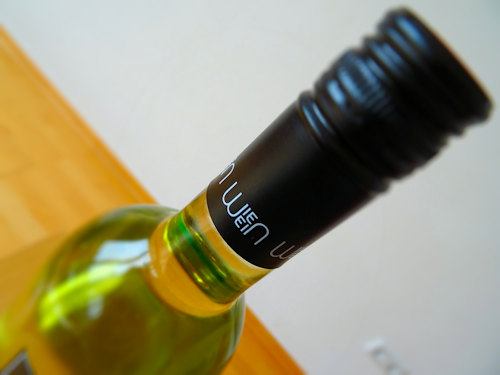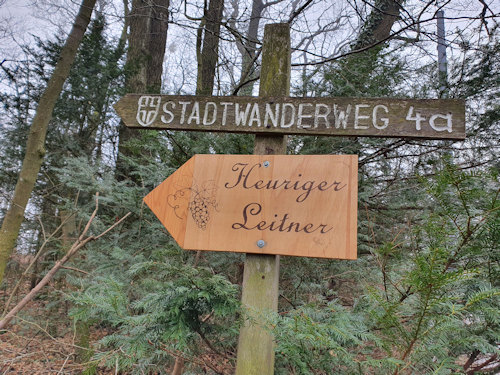
How many litres of wine do you think the city of Vienna grows each year?
0?
Maybe 50 (from some clever homeowner with a south-facing garden terrace)?
The answer is over 2.5 million. And it’s quality wine, too.
- The only large city in the world with a major wine-growing industry (I think)
- Most wines are regional varieties, like Grüner Veltliner or Blauer Zweigelt
- Most wineries sell locally through a wine tavern (Heuriger)
- See also:
- Food and drink in Vienna
- The August wine-growing festival
The Viennese vineyards

(A vineyard in one of the outer districts)
Wine production has always played an important role in the Viennese economy. When Rudolf I laid siege to the city in 1276, for example, one of his more powerful threats was to destroy the local vineyards.
Today, numerous (mostly small) wineries produce wine within the city limits on about 640 hectares of land. Which might make Vienna the only large city in the world with a significant wine growing industry.
And it doesn’t stop at wine.
When I last checked, Vienna contributed over 60% of Austria’s aubergine and cucumber production, as well as about a third of the country’s domestic tomatoes.
The city even sells its own range of organic food (look for the Wiener Gusto brand).
But back to wine…
Since growing vines on roundabouts, roadsides and high-rise balconies can pose quite a challenge, you might wonder how all that wine production is possible.
The answer is largely geographical luck.
The outer districts in the north and west of Vienna stretch into sunny hillsides, where the soils are perfect for a diverse mix of grape varieties. Various climatic influences (particularly the course of the Danube river) ensure the right weather conditions, too.
And these vineyards really are within the city limits; nobody slipped a brown paper envelope to the cartographers so they’d move the city border out into wine territory.
I live in a built-up area and the vineyard pictured above is one tram stop away.
Viennese wine

(A bottle of Grüner Veltliner)
White wine typically makes up most of the harvest. While you’ll find your Chardonnay and Sauvignon Blanc, the commonest grape variety is a fairly local one called Grüner Veltliner, popular in white wine spritzers.
Red wines include Merlot and Cabernet Sauvignon, but (again) another local variety is commonest: Blauer Zweigelt.
Of course, skeptics might question whether any of this is quality wine. After all, you don’t see the word Vienna on too many wine menus in the gourmet temples of London, Paris and New York.
You’d have to judge for yourself, but Viennese wines score well in national wine guides. And a 2023 list of the most influential wine producers in Austria (based on the opinions of top sommeliers ) included five from Vienna.
The city also has a hotly-contested annual Wiener Weinpreis (Vienna Wine Awards) with formal evaluations by an independent jury.
In 2021, for example, the city’s state-owned Cobenzl winery took home first prize in three categories: Sekt, Riesling kräftig and Weißburgunder kräftig. In 2022, they won the Rote Cuvées category. In 2023, the gold medal went to them in the Wiener Gemischter Satz DAC Ortswein category.
So, yes, vineyard manager is a legitimate career goal for a municipal employee.
Cobenzl also achieved full organic status back in 2023, so their wines produced from that year carry organic certification.
One reason you don’t see too much Viennese wine outside of Vienna is that the locals drink rather a lot of it, though some is exported as far afield as the USA.
Most wineries sell direct to consumers at the vineyard or through their own wine tavern (Heuriger). Local restaurants and supermarkets also stock the regional wines.
Look, for example, for the WienWein label (literally ViennaWine): a collaboration between leading wine estates in the city.
We even have a 4-day wine-growing festival: the Neustifter Kirtag.
The Heuriger

(This way to a Viennese wine tavern)
The heuriger wine tavern is a particular Austrian and Viennese phenomenon.
Although there are various types, the more traditional Heuriger opens only seasonally, serving local food from a buffet in addition to home-produced wine.
A visit to a Heuriger makes for a rather pleasant evening in the summer months, and the ones in Grinzing, Neustift am Walde, and Nussdorf (all in the 19th district) are particularly popular.
Take a close look at the buffets to discover various local delicacies, too, like Blunzen (blood sausage or black pudding), Grammelschmalz (fried bacon bits and lard) and Kummelbraten (roast pork belly with caraway seeds).
All part of a healthy balanced diet (possibly not).
“Mahlzeit”, as they say before meals in Austria.